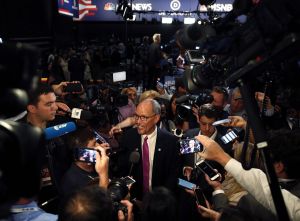Editor’s Note: Go Pats #InTomWeTrust #EverythingWeGot
With Super Bowl 53 set to kick-off tonight, it seems like not just fans of American football are looking forward to watching the game. The interrelationship of consumerism and sports entertainment continues to prosper through television broadcasting. Reaching over 100 million viewers each year, the Super Bowl is one of the most-watched television broadcasts in the United States. Although highly anticipated rival team match-ups prompt higher viewer frequencies, viewership ceases to drop due to the cultural popularity and social aspects of the sporting event. Top advertisers and companies year after year attempt to utilize the best marketing opportunity to make a mark in their industry. Over the 52 years of the Super Bowl being broadcasted on national television, costs and impact never cease to heighten.
You don’t need simple economics to realize that this high a level of viewership, combined with the relatively short supply of game time (approximately 4 hours), would result in exorbitantly high costs to purchase ad time. Accounting for inflation, the average cost for a 30 second advertisement during the first Super Bowl was $300,000. Today, the Super Bowl has become such a popular event, that a 30-second commercial will cost advertisers over $5 million US dollars. Last year’s 2018 Super Bowl generated over $400 million in ad revenues, counting for less than 50 total minutes of advertising time throughout the game.
Intense football fans may use the (costly) commercial intermissions as an actual hiatus from watching the game, but many Super Bowl viewers tend to be more inclined to watch the advertisements instead of the game itself. Super Bowl commercials appear to have become a cultural spectacle in itself, providing entertainment for viewers of all types as well as generating discussions. Because there is such a short time frame to make an impact on viewers, advertisers go to extreme lengths to create memorable and notable advertisements. Due to the large lump-sum payment required for a short advertising time slot in the game, many advertisers still question if running the ad is economically “worth it”, so to speak.
For advertisers, generating revenues is fundamental. However, advertising during the Super Bowl has created a situation where making a bold statement to the mass viewing audience becomes more important than any net accounting profit.Super Bowl advertising slots are most often sought after by large brands such as Budweiser, Apple, Coca-Cola, McDonald’s, American Express, so on and so forth. In past Super Bowls, these companies have attempted to stand out through techniques such as promoting new lines of product, featuring celebrities, or highlighting social issues, among others. However, while featuring new products or services can aid in generating future sales revenue, many of these top brands that run Super Bowl ads have already reached the majority of their targeted audience. Therefore, a single creative advertisement is not necessarily going to sway a person’s soft drink choice or favorite chocolate bar.
So, why do some brands still choose to advertise during the Super Bowl? More specifically, why are they willing to spend millions of dollars for those 30 seconds of ad time. Is it actually worth it for these Blue-chip companies to continue doing this year after year?
The answer is clearly not sole profits. Although advertising during the Super Bowl can result in net revenue loss, it can also be an incredibly effective tool for garnering brand awareness, maximizing global exposure, and gaining social influence. These factors become the driving forces that propel companies to execute costly yet unprecedented commercials in the Super Bowl. A single gripping advertisement can guide a company into new demographic spheres, potentially altering cultural domains of influence.
Formulating a Super Bowl commercial that raises brand awareness can create discussion for years to come, which proves to be more beneficial in the long run. In order to increase brand awareness, companies choose to utilize strategic tactics that draw upon human emotions, cultural themes, or new and unique concepts. For example, certain brands that carry specific demographic audiences, such as alcohol or food chains, can reach a larger consumer base. Budweiser’s Super Bowl advertisement from 2014, “Puppy Love”, which features a puppy becoming best “buds” with other animals, is one of the most popular and well-known Super Bowl commercials of all time. When people appreciate a company’s advertisements, they talk about them with their friends, inherently generating a higher level of brand awareness and identity.
The sheer number of consumers that are exposed to your advertisement during the game is certainly an important point of consideration for firms. Exposure parallels brand awareness, partially due to the number of websites displaying top Super Bowl advertisements on a yearly basis. For the latter part of the population who do not watch the game, dominant advertisements remain on the internet forever. The secondary effects of potentially getting added to BuzzFeed’s list of “Best 2018 Super Bowl Commercials”, by being considered as eminent and memorable, extend a brand’s exposure to further audiences for an extended time frame.
Super Bowl commercials exert a considerable amount of social influence. A brilliant Super Bowl commercial is a legitimate vehicle towards exercising influence in a capitalist society that is based around the marketplace. Apple’s famous “1984” commercial, which aired during the 1984 Super Bowl, represented a turning point in technology. Its notable line announcing Macintosh computers, “And you’ll see why 1984 won’t be like ‘1984’”, has become one of the most memorable advertising lines in the industry’s history. Using a futuristic theme, the one-minute commercial highlighted a critical juncture in society for information technology.
Year by year, the marketing industry ultimately takes advantage of this peak in consumer volume. The sheer force placed our capitalist society by these leading multinational corporations’ advertisements is monumental. Although profits may not always be as large as one would expect, the secondary effects of these advertisements demonstrate a positive economic alternative for brands.




